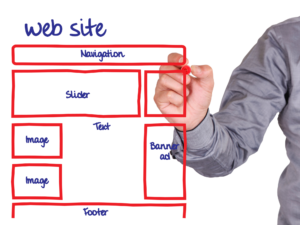What Is The Difference Between A DIY And A Professionally Designed Website?

Are you thinking of taking your business online? Whether you offer a product or service, you could benefit from a well-designed website. You may find yourself choosing between doing it yourself (DIY) with a template site or having it done professionally. What’s the difference between them?
Customizing Your Design
 If you’re thinking of making a website for your business, you probably already have a vision for it. Getting this idea into the real world takes versatility, which is one of the strong suits of professionally designed websites. Layouts, graphic design, content, mobile optimization – professional web developer teams should be proficient in all this and more.
If you’re thinking of making a website for your business, you probably already have a vision for it. Getting this idea into the real world takes versatility, which is one of the strong suits of professionally designed websites. Layouts, graphic design, content, mobile optimization – professional web developer teams should be proficient in all this and more.
With a professional team creating your project, you’ll rely on a team’s worth of experience in different areas as they take care of your entire website design. DIY sites, on the other hand, limit what you can do with templates, which can be very frustrating when you’re attempting to take your vision into reality all by yourself!
Of course, you have to think about more than just the layout of your site; security, for one, especially if you’re processing payments through your site. Template sites have servers hosting hundreds or thousands of other websites; the shared space means hacking one could lead to finding access to yours. Professional web designers have to be careful with security and often dedicate individual servers to each client!
Bottom line: the final website made with a professional is a unique design specifically made for your business.
Search Engine Optimization Capabilities
A professionally designed site takes SEO seriously from the very start. It’s because we’re not starting a project completely from scratch: we use a keyword strategy when putting together all the elements. It helps us turn every possible part of your website into an SEO tool – from front-facing images, videos, and web copy to behind-the-scenes features like metadata and sitemaps.
A DIY site design also has restricted SEO functionality with its widgets and coding. You have to figure out the keywords your target audience is using and plan out your content on this basis. Even if you come up with a great plan of action for your keywords, most online website builders used for doing it yourself have limited built-in SEO tools and very basic guides to teach you how to use them!
Consistency In Branding
 You’re good at what you do – it’s why you’re setting up a website for your business! This website is your best marketing tool, a chance to show not just those on social media but the entire world why you’re awesome. But unless you’re in the marketing game, you might make a few unforced errors while setting up your DIY website.
You’re good at what you do – it’s why you’re setting up a website for your business! This website is your best marketing tool, a chance to show not just those on social media but the entire world why you’re awesome. But unless you’re in the marketing game, you might make a few unforced errors while setting up your DIY website.
Professional web designers know the importance of consistency in branding and the best ways to get your message out to your target audience. You may not know how colour palettes, calls to action, the placement of content on web pages, or even the wording of small bits of text can make a big difference in how your company is perceived.
Hidden Costs
Finally, one of the major differences between DIY and professionally designed websites is the costs involved. A dependable web designer will be upfront about the price for your new site. With a DIY site, you’ll need to watch your bank account every step of the way! Almost every new feature, plugin, or form will have an extra cost added to your bottom line.
The final hidden cost is what your website will cost your company if not effective. Creating a website that doesn’t work for your bottom won’t be worth the time or the trouble. Creating one that does might cost a bit more upfront, but it will pay for itself many times over. It’s the biggest difference between a DIY website and a professionally designed one!